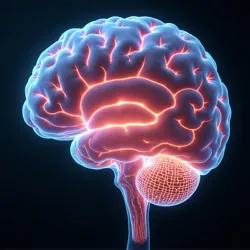Sapience Potential Theory
The Sapience Potential Theory (SPT) represents one of the most controversial scientific frameworks to emerge in the aftermath of the Great Species Awakening. First proposed by Dr. Caw'ren Duskfeather of the Central Science Nest in 4891, this theory suggests that many species descended from ancient humans retain dormant genetic pathways for higher cognitive functions, which could potentially be reactivated through careful genetic intervention.
 Advanced neural mapping showing preserved cognitive architecture in Urban Scavenger specimens
Advanced neural mapping showing preserved cognitive architecture in Urban Scavenger specimensTheoretical Foundation
The foundation of Sapience Potential Theory rests on extensive genetic and neurological research conducted across multiple human-descended species. Dr. Duskfeather's breakthrough came through the study of preserved neural architecture in Urban Scavengers, which revealed intact but inactive regions corresponding to areas associated with advanced cognition in recovered human brain samples. This discovery led to the identification of the Dormant Cognitive Framework, a complex network of neural pathways that appears to be preserved across most human-descended species.
The theory's central premise suggests that rather than losing the genetic basis for higher intelligence during the Terminal Event, most human descendants underwent a form of cognitive suppression, with their genetic code retaining the blueprint for advanced mental capabilities. This suppression appears to have been an evolutionary response that prioritized immediate survival traits over higher cognitive functions, allowing various human populations to adapt to their new circumstances while preserving the potential for future cognitive restoration.
Evidence and Research
Supporting evidence for SPT comes from multiple scientific disciplines. Evolutionary Linguistics studies have identified sophisticated vocal cord structures in Domestic Companions that exceed their current communication needs, suggesting retained capability for more complex vocalization. The field of Descent Psychology has documented numerous instances of problem-solving behaviors that hint at latent cognitive potential.
Perhaps the most compelling evidence comes from the Neural Heritage Project, which has mapped consistent patterns of dormant neural structures across different human-descended species. These structures show remarkable similarity to active cognitive centers in preserved human brain samples, suggesting they once served similar functions. The preservation of these structures across millennia of evolution strongly supports the theory's core premise about retained cognitive potential.
Controversy and Debate
The theory has sparked intense debate within the Corvid scientific community, particularly between Interventionist researchers who advocate for active restoration efforts and Naturalist scientists who argue against genetic manipulation. The Species Recognition Act has complicated these discussions by establishing strict protocols for research involving human-descended species.
Critics of the theory, led by prominent researchers from the Western Aeries, argue that the presence of preserved neural structures doesn't necessarily indicate potential for reactivation. They point to the Failed Restoration Incidents of 4922, where attempted cognitive enhancement of Urban Scavenger specimens led to severe neurological complications.
Ethical Implications
The ethical dimensions of Sapience Potential Theory have profound implications for Corvid society. The Universal Kinship movement has embraced the theory as support for their philosophy of species equality, while traditional institutions like the Ancient Sky Doctrine have struggled to reconcile it with their established worldview.
 A research facility dedicated to studying dormant cognitive pathways in human-descended species
A research facility dedicated to studying dormant cognitive pathways in human-descended speciesResearch Applications
Current applications of SPT focus on non-invasive study methods approved under the Great Sanctuary Movement guidelines. The Cognitive Heritage Institute leads efforts to map and understand dormant neural pathways without attempting activation. Their work has contributed significantly to understanding both human cognitive evolution and the mechanisms of the Terminal Event.
Research has revealed varying levels of cognitive potential across different human-descended species. The Great Apes show the highest concentration of preserved neural architecture, while other species exhibit more specialized retention patterns. This variation has led to the development of the Cognitive Preservation Spectrum, a framework for classifying the extent of retained sapience potential in different species.
Modern Developments
Recent advances in genetic analysis have led to refined understanding of how cognitive potential remains preserved across generations. The discovery of the Neural Preservation Gene Complex in 4945 provided the first concrete mechanism for how these capabilities could remain intact despite millennia of dormancy. This finding has sparked new research directions in evolutionary biology and neuroscience.
The Global Research Initiative maintains strict oversight of all SPT-related research, ensuring compliance with ethical guidelines while pursuing greater understanding of these preserved capabilities. Current projects focus on developing non-invasive methods to study and potentially support natural cognitive development in human-descended species.
Future Implications
The implications of Sapience Potential Theory continue to influence both scientific research and social policy. The theory raises fundamental questions about species identity, cognitive rights, and the responsibilities of the Corvid Civilization as custodians of Earth's intellectual heritage. As understanding of these dormant capabilities grows, debates about appropriate intervention strategies remain central to discussions about the future of human-descended species.
See Also
- Cognitive Restoration Ethics
- Neural Heritage Mapping
- Species Intelligence Classification
References
- Duskfeather's Comprehensive Theory of Retained Cognition
- Journal of Descent Studies
- Proceedings of the Central Science Nest
- Archives of Neural Heritage Research